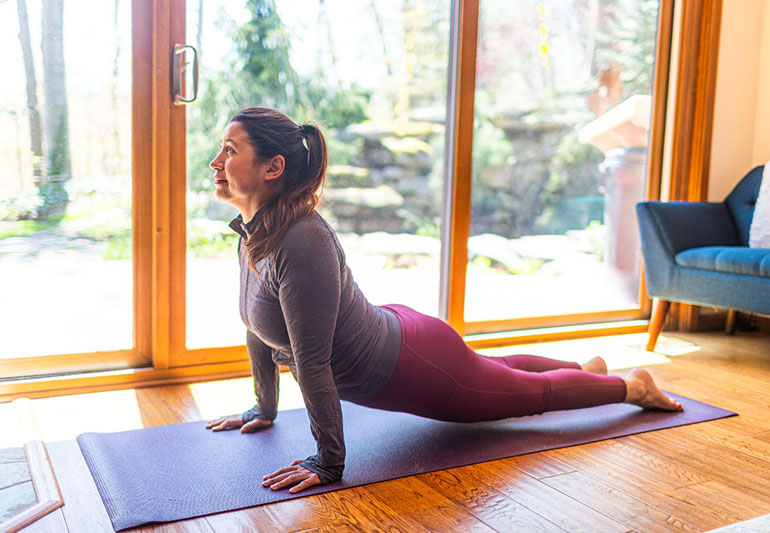A Five-Minute Guide to Doing Yoga at Home

Doing yoga at home is an important part of your practice even if you have a studio membership. If you’re used to taking group classes, find out how different it feels to do the same poses on your own.
You’ll probably start out feeling more relaxed when you don’t have to drive through downtown traffic before your first sun salutation. You’ll also be able to design routines based on what your body needs each day rather than doing whatever the teacher says.
Discover the joys of rolling out your yoga mat in your own living room or back yard. Try these suggestions for developing a home practice you’ll love.
Preparing for Your Home Yoga Sessions:
1. Check your flooring. Hardwood floors are ideal, but you can modify other surfaces with a portable yoga board or dance floor kit. It will help protect your knees and wrists.
2. Collect props. At a minimum, you’ll want a comfortable mat and any other props that help you to move safely. That might include blocks, bolsters, and straps. Keep in mind that you can use free substitutes like pillows and books.
3. Eat light. A full stomach can interfere with any workout. Try to wait a couple of hours before your last meal or snack on something light such as yogurt or fruit.
4. Stay warm. Stretching is more pleasant when your body feels a little toasty. Dress in layers so you can make adjustments as needed. Use a space heater if you like to keep your thermostat set low.
5. Minimize distractions. Do you struggle with frequent interruptions at home? Turn off your phone and TV to avoid temptation. Let your family know you’re unavailable for the next hour.
Arranging Your Home Yoga Sessions:
1. Follow instructions. If you’re new to yoga, some expert training will help you to stay safe. Ask a local studio about hiring one of their instructors to teach you at home. Many studios also have online video collections included in their memberships.
2. Build your sequence. There are many factors involved in sequencing a yoga session. Working with an instructor or video will give you a format to follow until you learn the basics.
3. Set your intention. Many students like to create a specific focus or goal each day. You may want to strengthen your core or promote world peace.
4. Listen to your body. Solo practice trains you to become your own teacher. You’ll learn to follow your internal cues instead of depending on external instructions.
5. Learn modifications. Any pose can be adjusted to make it safer and more effective for your body. Research common modifications or ask an experienced teacher for suggestions.
6. Start out gradually. Even if you’re used to hour long studio classes, you may run out of steam quickly when you’re the only one in the room. Let yourself enjoy yoga for 10 or 15 minutes at a time as you work your way up to longer intervals.
7. Find a buddy. In addition to your solo days, you might want to share yoga with a friend who has compatible goals. Advertise at your local studio for a workout buddy. You could support each other in making your workouts more enjoyable and consistent.
8. Play music. Studies show that music can help you exercise harder without feeling more strain. Choose traditional yoga music or play any tunes you like from pop to country.
9. Cool down. Transitioning gradually out of any workout helps your body to recover and grow stronger. Set aside your final moments for svanasana, the slow and quiet poses that help you to return to ordinary activities feeling refreshed and renewed.
Home yoga sessions provide important benefits for beginners and advanced practitioners. A well-rounded routine will balance studio classes and private time so you can focus on your own needs and connect with other yoga students.
CLICK HERE to Explore Our Free Online Courses

Responses